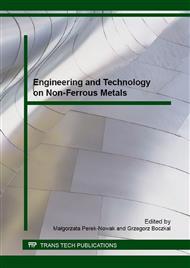[1]
J. Kostrzewski, Skarby i luźne znaleziska metalowe od eneolitu do wczesnego okresu żelaza z górnego i środkowego dorzecza Wisły i górnego dorzecza Warty, Przegląd Archeologiczny 15 (1962) 5-133.
DOI: 10.3161/00159301ff1971.17.21.559
Google Scholar
[2]
A. Garbacz-Klempka, S. Rzadkosz, J. Górski, Artefacts from Krakow-Nowa Huta as an Illustration of Selected Issues of Research Into Prehistoric and Mediaeval Casting, Metallurgy and Foundry Engineering 39 (2013) 23–28. DOI: mafe. 2013. 39. 2. 23.
DOI: 10.7494/mafe.2013.39.2.23
Google Scholar
[3]
K. Adamczak, Ł. Kowalski, A. Garbacz-Klempka, K. Dobrzański, Siekieromłot typu Szendrő z Karłowic Małych, woj. opolskie w świetle analiz archeologicznych i metaloznawczych, Śląskie Sprawozdania Archeologiczne 57 (2015) in press.
Google Scholar
[4]
K. Chmielecki, Stare bronzy w zbiorach Towarzystwa Naukowego w Toruniu, Roczniki Towarzystwa Naukowego w Toruniu 3 (1906) 65-82.
DOI: 10.15762/zh.2016.09
Google Scholar
[5]
E. Pernicka, F. Begemann, S. Schmitt-Strecker, H. Todorova, I. Kuleff, Prehistoric copper in Bulgaria, Eurasia Antiqua 3 (1997) 41-180.
Google Scholar
[6]
S.R.B. Cook, S. Aschenbrenner, The Occurence of Metallic Iron in Ancient Copper, Journal of Field Archaeology 2/3 (1975) 251-266.
Google Scholar
[7]
J. Heeb, Copper shaft-hole axes and early metallurgy in South-Eastern Europe, Archaeopress Archaeology, Oxford, (2014).
DOI: 10.2307/j.ctvqc6jzt
Google Scholar
[8]
A. Hauptmann, The Archaeometallurgy of Copper. Evidence from Faynan, Jordan, Springer, Berlin-New York, (2007).
DOI: 10.2113/gsecongeo.103.2.456-a
Google Scholar
[9]
E. Pernicka, Gewinnung und Verbreitung der Metalle in prähistorischer Zeit (=Jahrbuch des Römisch-Germanischen Zentralmuseum 37), Römisch-Germanischen Zentralmuseum, Mainz, (1990).
DOI: 10.2307/298797
Google Scholar
[10]
T. B. Massalski (Ed. -in-Chief), H. Okamoto, P. R. Subramanian, L. Kacprzak (Eds. ), Binary Alloy Phase Diagrams, ASM International, Materials Park, Ohio, (1990).
DOI: 10.1002/adma.19910031215
Google Scholar
[11]
A. Bolewski, A. Manecki, Mineralogia szczegółowa, PAE, Warszawa, (1993).
Google Scholar
[12]
A. Pike, Appendix : Analysis of Caucasian Metalwork – The Use of Antimonal, Arsenical and Tin Bronze in the Late Bronze Age, in: J. Curtis, M. Kruszyński (Eds. ), Ancient Caucasian and Related Material in The British Museum, The British Museum Press, London, 2002, pp.87-98.
Google Scholar
[13]
M. Gedl, Die Fibeln in Polen (=Prähistorische Bronzefunde XIV: 10), Franz Steiner Verlag, Stuttgart, (2004).
DOI: 10.54799/jqpg7756
Google Scholar


